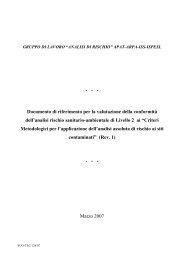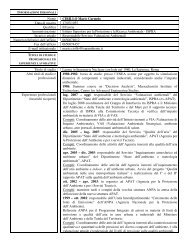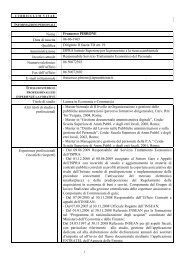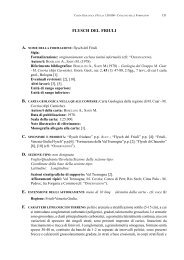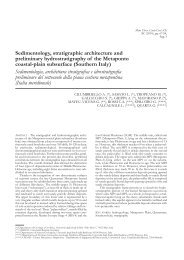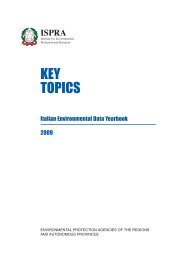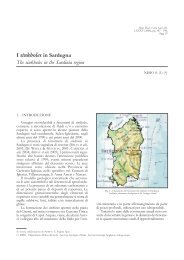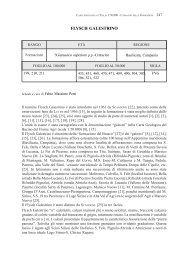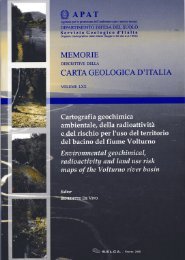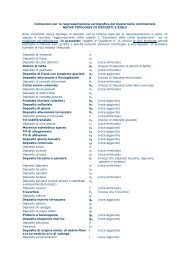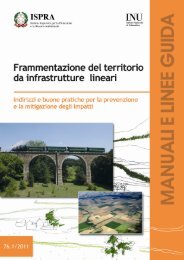Guidebook - Ispra
Guidebook - Ispra
Guidebook - Ispra
You also want an ePaper? Increase the reach of your titles
YUMPU automatically turns print PDFs into web optimized ePapers that Google loves.
THE APULIA CARBONATE PLATFORM-MARGIN AND SLOPE, LATE JURASSIC TO<br />
EOCENE OF THE MAIELLA MT. AND GARGANO PROMONTORY:<br />
PHYSICAL STRATIGRAPHY AND ARCHITECTURE P18<br />
al., 1997). The type section is exposed near the town<br />
of Monte S. Angelo, along the road to Val Carbonara<br />
and S. Giovanni Rotondo.<br />
(4) Maiolica 2. Same facies of the Maiolica 1<br />
described above.<br />
Upper Sequence Boundary --- There is a rather<br />
abrupt change in lithology in slope and basinal<br />
settings: both the Maiolica 2 and Mattinata 1 Fm<br />
are overlain by a marly and shaly succession, the<br />
so-called Scisti a Fucoidi Formation (Cobianchi et<br />
al., 1997), early Aptian-late Albian in age. From a<br />
physical stratigraphic point of view, the sequence<br />
boundary is clearly a drowning event: the platform<br />
and its bioclastic apron (Mattinata Fm) is abruptly<br />
backstepped for some 5-10 km, suggesting that<br />
shallow deposition was terminated in a short time.<br />
Mattinata 2 Sequence (Early Aptian - Late Albian)<br />
- This sequence is largely represented by slope and<br />
basin deposits. Equivalent shallow-water deposits are<br />
present only at Monte degli Angeli and Coppa di Pila<br />
and in the area between Rignano and Manfredonia.<br />
The sequence, characterized in the upper part by a<br />
strong progradational trend, is represented by the<br />
following formations.<br />
(1) San Giovanni Rotondo 2 Limestone. This unit,<br />
which corresponds to Masseria Quadrone Limestone<br />
of Merla et al. (1969), is an inner-platform succession<br />
of Albian-Cenomanian? age. It consists of thick beds<br />
of mudstone-wackestone with peloidal packstonegrainstone<br />
intercalations. Recently, Luperto Sinni<br />
(1996) described a thin succession (about 30 m) of<br />
mudstone-packstone with late Albian orbitolinids in<br />
the same area; the top consists of a Sellialveolina<br />
vialli-bearing limestone, early Cenomanian in age.<br />
(2) Monte degli Angeli 2 Limestone. It is the Late<br />
Aptian to Middle-Late Albian tract of the Lower<br />
Cretaceous margin of the ACP. It is grafted onto<br />
the underlying Hauterivian-early Aptian platform<br />
margin, but, in places, there may be 1-2 m of pelagic<br />
limestone. The Monte degli Angeli Limestone is<br />
rich in sponges, chaetetids, corals, and rudists and<br />
represents the bioconstructed margin of this sequence.<br />
The age of the outcropping part of this formation is<br />
limited to the late Aptian, whereas the Albian part<br />
is documented only in platform-derived breccia<br />
occurring in the Mattinata 2 Fm.<br />
(3) Marne a Fucoidi Formation. This lithological<br />
unit, rich in marls and black shales, deposited during<br />
episodic anoxic events (Cobianchi et al., 1997; 1999),<br />
has a maximum thickness of 120 m in the northern<br />
Gargano (Figure15), and overlies both the Maiolica<br />
2 and Mattinata 1 formations. It clearly represents<br />
a rather abrupt change in the basinal sedimentation<br />
and is associated with a standstill in the platform<br />
evolution. In the Monte S. Angelo area, the Marne<br />
a Fucoidi wedges out against the platform slope and<br />
is absent on the platform top, where a few meters<br />
of pelagic limestone or an unconformity surface are<br />
present.<br />
(4) Mattinata 2 Formation. It is the same slope and<br />
base-of-slope succession as the previously described<br />
Mattinata 1 Fm, from which it is separated by a<br />
wedge of pelagic limestone with thin beds of black<br />
shale (Marne a Fucoidi Fm). The Aptian-Albian tract<br />
Figure 15 - Stratigraphic section of the Marne a Fucoidi<br />
Fm in the northern Gargano (Fontanelle section<br />
– Ischitella) (after Cobianchi et al. 1997)<br />
13 - P18<br />
Volume n° 3 - from P14 to P36



